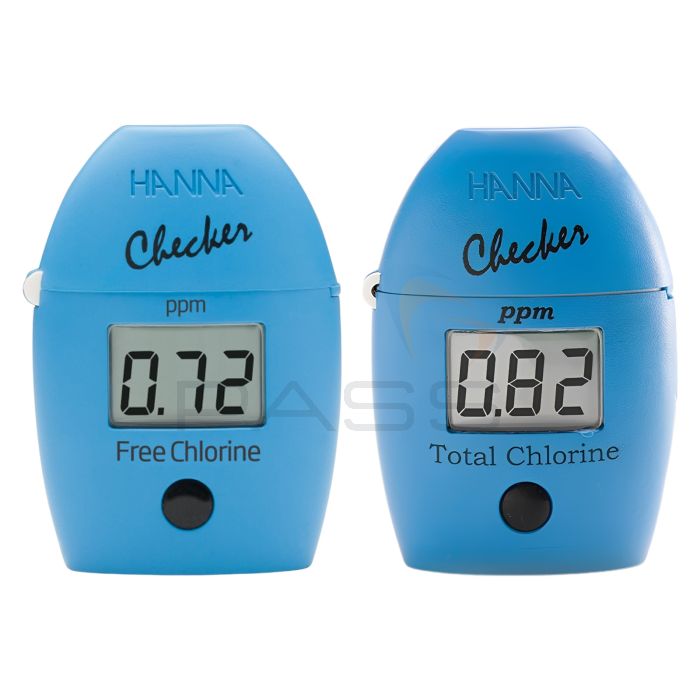Hanna Instruments Chlorine Handheld Colourimeter Checker HC

- Quick and easy testing
- High precision results
- Auto shut-off
- Free or Total chlorine options
SKU
HI-701/11
These Hanna Chlorine Checkers fit in the palm of your hand and deliver results with the touch of a button. They have a large LCD and an auto shut-off feature. Two models are available: a free chlorine and a total chlorine checker.
Chlorine is the most common water disinfectant. Once in the water, it presents as free chlorine and total chlorine. Free chlorine is the chlorine left in the water to tackle bacteria. As the process of disinfection takes place, the levels of free chlorine will reduce. Total chlorine is the measurement of free and used chlorine in the water.
Ideal for
- HI-701 Free Chlorine
- Swimming pools and spas
- Fruit, vegetable and salad washing
- Disinfection
- Aquaculture
- HI-711 Total Chlorine
- Swimming pools and spas
- Water and quality control checks
- Disinfection
- Wastewater treatment
- Marine and saltwater Aquaculture
- The instruments can also determine chlorine levels in fish tanks for optimum fish and plant health. Use alongside recommended dechlorination.
Key Features
- Four-step process
- Zero the Checker
- Add reagent
- Insert sample into Checker
- Press the button for results
- Testing is quick and easy
- High precision results - more accurate than chemical test kits
- Auto shut-off feature means the Checker cannot remain on by mistake
- Fully portable, fitting easily into both palm and pocket
What's Included?
- HI-701
- Free Chlorine Checker
- Two sample cuvettes
- Cuvette cap
- Six starter packs of reagents (HI-701-25)
- 1.5 AAA battery
- Instructions
- HI-711
- Total Chlorine Checker
- Two sample cuvettes
- Cuvette cap
- Six starter packs of reagents (HI-711-25)
- 1.5 AAA battery
- Instructions
Product Range
- Hanna Instruments HI-701 Free Chlorine Checker
- Hanna Instruments HI-711 Total Chlorine Checker
Technical Information
Specification
| HI-701 | HI-711 | |
|---|---|---|
| Range | 0.00 to 2.50 ppm (mg/L) | 0.00 to 3.50 ppm (mg/L) |
| Resolution | 0.01 ppm (mg/L) | |
| Precision | 3% of reading ±0.03 ppm (mg/L) @ 25°C | |
| Light Source | LED @ 525 nm | |
| Light Detector | Silicon photocell | |
| Environment | 0 to 50°C (32 to 122°F); RH max 95% non-condensing | |
| Battery Type | (1) 1.5V AAA | |
| Auto-off | After 2 minutes of non-use and after reading | |
| Dimensions | 81.5 x 61 x 37.5 mm (3.2 x 2.4 x 1.5") | |
| Weight | 64 g (2.25 oz.) | |
| Method | Adaptation of USEPA method 330.5. The reaction between free chlorine and the DPD reagent will cause a pink tint in the sample. | EPA approved DPD method Standard Method 4500-Cl G. |
| Interference may be caused by | Bromine, Iodine, Ozone, Oxidised forms of Chromium and Manganese. In case of water with hardness greater than 500 mg/L CaCO3, shake the sample for approximately 2 minutes after adding the powder reagent. If the water used for this procedure has an alkalinity value greater than 250 mg/L CaCO3 or acidity value greater than 150 mg/L CaCO3, the colour of the sample may develop only partially, or may rapidly fade. To resolve this, neutralise the sample with diluted HCl or NaOH. PLEASE NOTE: In some cases, samples may contain other parameters which may interfere with results |
|
Document Downloads
Hanna Instruments HI-701 Free Chlorine Handheld Checker User Manual
Hanna Instruments HI-711 Total Chlorine Handheld Checker User Manual
Additional Information
SKU
HI-701/11
Hanna Instruments Chlorine Handheld Colourimeter Checker HC
£72.00
£86.40 inc vat
£72.00
£86.40 inc vat



